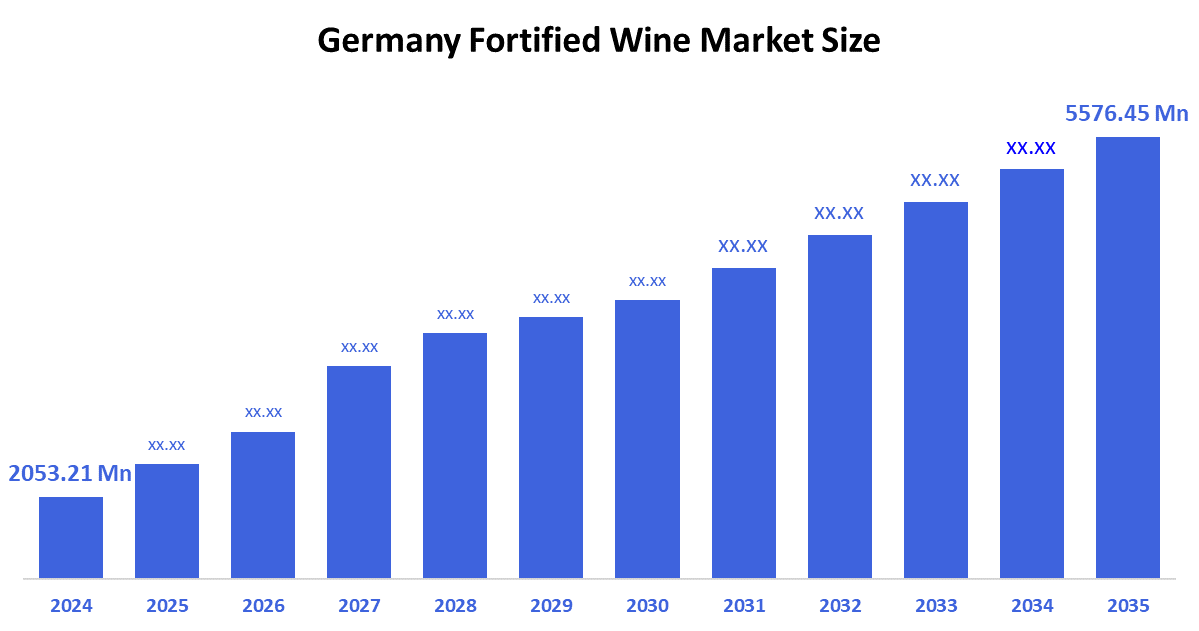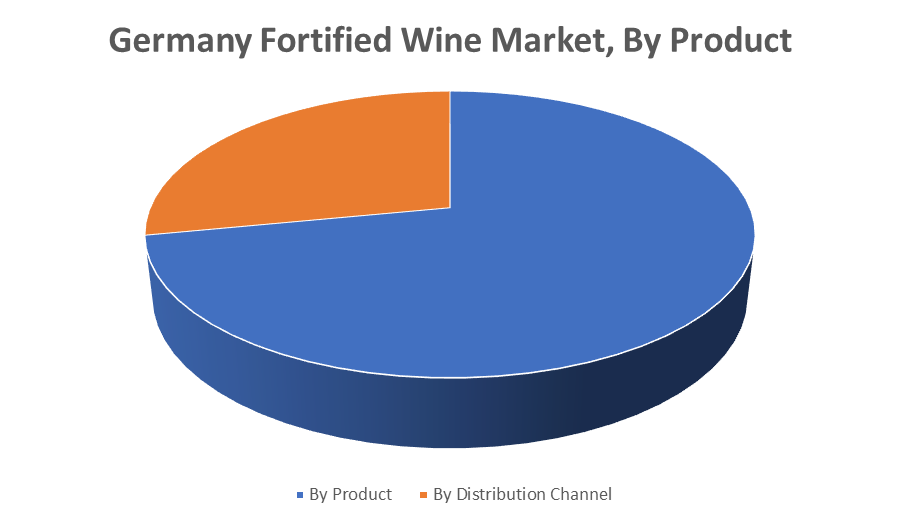Germany Fortified Wine Market
Germany Fortified Wine Market Size, Share, and COVID-19 Impact Analysis, By Product (Port Wine, Vermouth, and Sherry), By Distribution Channel (liquor stores, Pub, Bars & Restaurants, Internet Retailing, Liquor Stores, and Supermarkets), and Germany Fortified Wine Market Insights, Industry Trend, Forecasts to 2035
Report Overview
Table of Contents
Germany Fortified Wine Market Insights Forecasts to 2035
- The Germany Fortified Wine Market Size Was Estimated at USD 2053.21 Million in 2024
- The Market Size is Expected to Grow at a CAGR of around 9.51% from 2025 to 2035
- The Germany Fortified Wine Market Size is Expected to Reach USD 5576.45 Million by 2035

According to a research report published by Decision Advisors & Consulting, the Germany Fortified Wine Market Size is Anticipated to reach USD 5576.45 Million by 2035, growing at a CAGR of 9.51% from 2025 to 2035. Technical advancement, manufacturing development, and taste innovation are driving market expansion. The industry's expansion is also being aided by the growing demand for and consumption of alcoholic beverages at various special events. Product consumption is regarded as social recognition, which will propel industry expansion throughout the course of the projection period.
Market Overview
Fortified wine is created by adding a distilled spirit, usually, but not limited to, brandy to wine to turn it into a fortified wine, which has a higher alcohol content than regular wine. Fortifying the wine often influences its flavor profile while also enriching, sweetening, and intensifying its complexity. Fortified wines contain antioxidants, like resveratrol, that are known to promote heart health and can lower the risk of certain diseases. Fortified wines, especially those created from red grapes, are meant for wealthier consumers and allow them to try finer and richer alcoholic beverages. The rise of modern supermarkets and online sales has made fortified wines more accessible. Fortified wines are fashionable, as they can be seen as a source of social prestige and reputation. Fortified wines can also be found in cocktails or paired with dessert, and can be enjoyed on their own, with food, or as a dessert wine. Fortified wines are gaining popularity worldwide through wine tourism, as it involves festivals, food & wine pairings, and guided tours of wineries and winemaker facilities.
Report Coverage
This research report categorizes the market for Germany fortified wine market based on various segments and regions forecasts revenue growth, and analyses trends in each submarket. The report analyses the key growth drivers, opportunities, and challenges influencing the Germany fortified wine market. Recent market developments and competitive strategies such as expansion, product launch, and development, partnership, merger, and acquisition have been included to draw the competitive landscape in the market. The report strategically identifies and profiles the key market players and analyses their core competencies in each sub-segment Germany fortified wine market.
Driving Factors
The growing consumer interest in premium and craft alcoholic beverages, as well as awareness of wine culture. Greater discretionary income and shifting lifestyles are producing an effective demand for consuming a more varied and sophisticated drinking option set. Additionally, the growing food and beverage sector, particularly in urban markets, is increasing consumption with pairings and the growing online retail support and distribution networks are augmenting access.
Restraining Factors
Premium fortified wines are costly, which discourages price-sensitive consumers. Competition from spirits, craft beers, cocktails, and low-alcohol alternatives limits their market share. Increasing awareness of the health risks associated with drinking alcohol and the preferences for low- or non-alcoholic drinks has resulted in their decreasing demand. Taxes at high levels, labeling requirements that vary from jurisdiction to jurisdiction, rapidly changing prices of raw materials, and difficulties in logistics have limited growth possibilities.
Market Segmentation
The Germany fortified wine market share is classified into product and distribution channel.
- The port wine segment held a significant share in 2024 and is expected to grow at a significant CAGR during the forecast period.
The Germany fortified wine market is segmented by product into port wine, vermouth, and sherry. Among these, the port wine segment held a significant share in 2024 and is expected to grow at a substantial CAGR during the forecast period. The market is anticipated to develop as a result of vermouth wine's growing use as an antiseptic and medication to treat viral and cold illnesses.
- The liquor stores segment held a significant share in 2024 and is expected to grow at a significant CAGR during the forecast period.
The Germany fortified wine market is segmented by distribution channel into liquor stores, pub, bars & restaurants, internet retailing, liquor stores, and supermarkets. Among these, the liquor stores segment held a significant share in 2024 and is expected to grow at a significant CAGR during the forecast period. Their wide product selection, expert staff, and strong consumer trust. These stores offer convenient access to premium and imported fortified wines, catering to a growing segment of discerning drinkers. Additionally, rising interest in wine culture and at-home consumption supports ongoing growth. With expanding urbanization and increasing disposable income.
Competitive Analysis:
The report offers the appropriate analysis of the key organizations/companies involved within the Germany fortified wine market along with a comparative evaluation primarily based on their product offering, business overviews, geographic presence, enterprise strategies, segment market share, and SWOT analysis. The report also provides an elaborate analysis focusing on the companies' current news and developments, including product development, innovations, joint ventures, partnerships, mergers & acquisitions, strategic alliances, and others. This allows for the evaluation of the overall competition within the market.
List of Key Companies
- Henkell & Co. Sektkellerei
- Peter Mertes KG
- Schloss Wachenheim AG
- Dr. August Oetker
- Hawesko Holding AG
- Rheinberg Kellerei
- Jacques Wein?Depot
- Cantina Vecchia Torre
- Franz Wilhelm Langguth Erben
- Moselland eG Winzergenossenschaft
- Others
Key Target Audience
- Market Players
- Investors
- End-users
- Government Authorities
- Consulting and Research Firm
- Venture capitalists
- Value-Added Resellers (VARs)
Market Segment
This study forecasts revenue at Germany, regional, and country levels from 2020 to 2035. Decision Advisors has segmented the Germany fortified wine market based on the below-mentioned segments

Germany Fortified Wine Market, By Product
- Port Wine
- Vermouth
- Sherry
Germany Fortified Wine Market, By Distribution Channel
- Pub, Bars & Restaurants
- Internet Retailing
- Liquor Stores
- Supermarkets
Frequently Asked Questions
Q.1: What is the market size of the Germany Fortified Wine Market in 2024?
A: The Germany Fortified Wine Market size was estimated USD 2053.21 Million in 2024.
Q.2: What is the forecasted CAGR of the Germany Fortified Wine Market from 2024 to 2035?
A: The market is expected to grow at a CAGR of around 9.51% during the period 2024–2030.
Q.3: Who are the top 10 companies operating in the Germany Fortified Wine Market?
A: Key players include Henkell & Co. Sektkellerei, Peter Mertes KG, Schloss Wachenheim AG, Dr. August Oetker, Hawesko Holding AG, Rheinberg Kellerei, Jacques Wein?Depot, Cantina Vecchia Torre, Franz Wilhelm Langguth Erben, Moselland eG Winzergenossenschaft, Others
Q.4: What are the main drivers of growth in the Germany Fortified Wine Market?
A: The growing consumer interest in premium and craft alcoholic beverages, as well as awareness of wine culture. Greater discretionary income and shifting lifestyles are producing an effective demand for consuming a more varied and sophisticated drinking option set.
Q.5: What is the main restraining of growth in the Germany Fortified Wine Market?
A: Premium fortified wines are costly, which discourages price-sensitive consumers. Competition from spirits, craft beers, cocktails, and low-alcohol alternatives limits their market share.
Check Licence
Choose the plan that fits you best: Single User, Multi-User, or Enterprise solutions tailored for your needs.
We Have You Covered
- 24/7 Analyst Support
- Clients Across the Globe
- Tailored Insights
- Technology Tracking
- Competitive Intelligence
- Custom Research
- Syndicated Market Studies
- Market Overview
- Market Segmentation
- Growth Drivers
- Market Opportunities
- Regulatory Insights
- Innovation & Sustainability
Report Details
| Pages | 180 |
| Delivery | PDF & Excel via Email |
| Language | English |
| Release | Aug 2025 |
| Access | Download from this page |
